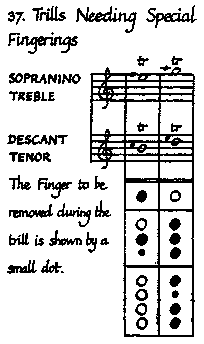PLAYING THE RECORDERS - online tutorial
How to Play The Descant, Treble, Tenor and Bass Recorders, full online instruction.
| Share page | Visit Us On FB |
|
Ornamentation |
||
|
ings to produce the desired result neatly without extraneous notes making themselves heard. Two frequently used special fingerings are shown in example 37. Other special fingerings
are given in the chart in example |
||
|
|
||
|
3 8, but it must be admitted that some of these are only approximations to the true notes. It is best to study the trills as they are needed rather than to attempt to learn them all at once. It is also worth while experimenting with special fingerings of one's own.
There are two common and effective ways of ending a trill. These are shown in example 39 and it will be seen that in the first method the trill ends with a turn by descending to the note below the one on which the trill is executed. In the second method, the trill ends with a rest followed by a short note. In each case, the first note only of the trill is tongued.
A mordent consists of a quick shake between the main note and the note above; an inverted mordent consists of a quick shake between the main note and the note below. Both types of mordent are used in modern edited versions of old music. Different musicians have different names for mordents, but the notation used here is generally followed.
Both trills and mordents, when judiciously used, help to make a melody more lovely. They will need very careful rehearsing, and in executing a trill in old music the tendency to
64
 |
||